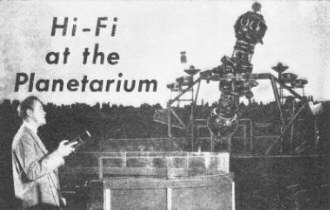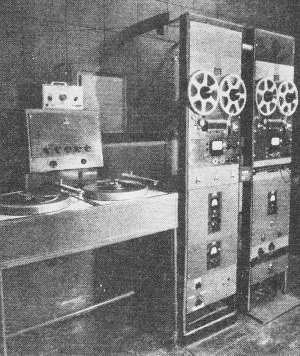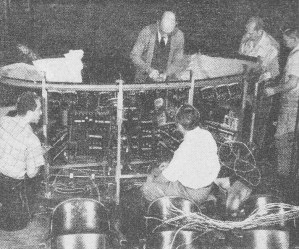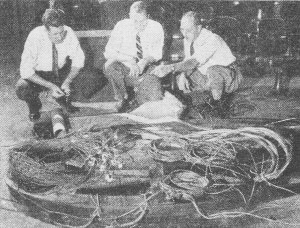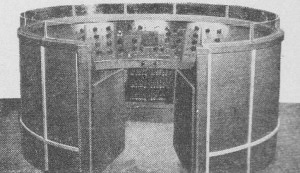Hi-Fi at the Planetarium
|
|
Audiophiles of the 1950s undoubtedly were impressed by the mention of a Rek-o-kut twin turntable with Pickering arms and pickups for playing records, let alone a twin Ampex tape system used both for recording and reproducing. That was awe-inducing stuff for the day, especially when applied to a planetarium show with visual and sound effects realistic enough to, "make adult members of the audience duck under their seats." We don't scare so easily these days. Here is the story of New York City's famous Hayden Planetarium after the marriage of the aforementioned sound and control system with its legendary Zeiss star projector. It appeared in the January 1955 issue of Popular Electronics magazine (which had just begun publication four months earlier). Hi-Fi at the Planetarium
Mr. Joseph M. Chamberlain (left), Chief Astronomer of the Planetarium, at the new control console. A mammoth electronic control console has been installed in New York City's famous Hayden Planetarium, Synchronizing the Planetarium's Zeiss Projector with an elaborate high-fidelity sound system, the console enables the "theater of the skies" to present its shows with startling realism of both visual and aural effects. The only instrument of its kind in the world, the new unit, as well as the entire sound system, was designed and installed by the Altec Service Corporation of New York, with Mr. Martin Bender, Commercial Engineer attached to Altec N.Y., supervising the entire operation, and Mr. Joseph M. Chamberlain, Chief Astronomer of the Planetarium, contributing to the guidance and scope of the program of improvement.
Hi-fi record and tape equipment, amplifiers, and controls are housed in soundproof room.
U.N. children saw home skies protected.
Altec and Planetarium technicians took six days to install the new unit. Almost a mile of wiring is used in the unusual instrument, as well as dozens of switches, knobs, relays, circuit breakers, and other components. The unit weighs 1500 pounds and took a year to design and build. Now in operation, it is capable of controlling 96 different combinations of special effects to enhance the theatrical possibilities of the Zeiss Projector. In addition, it controls any sequence of 15 different lighting machines, each of which includes up to a dozen different scenes that may be displayed. The resultant combination provides an almost fabulous range of possibilities for showing celestial phenomena. Synchronization of these visual effects with specially prepared sound effects is now so perfect, that the spectacle of a meteor hurtling toward the earth, accompanied by a terrifying noise, is enough to make adult members of the audience duck under their seats.
Martin Bender (right), designer, plans wiring and installation with Planetarium staff. The new control console is the climax of a five year program of improvement at the Planetarium, during which time Altec also installed a complete audio system. Chief problem facing Mr. Bender in this task was to diffuse correctly the sound in the dome-like room that is the Planetarium theater, as well as in the cylindrical room in which lectures are given. In both rooms the shape and architectural material worked against good acoustics rather than for it. The dome, in which music and speech as well as special sound effects were to be reproduced, received two speaker systems, each complete in itself with one woofer and two tweeters for maximum distribution of high frequency sounds. One system handles music and sound effects; the other reproduces the lecturer's voice and serves also as a standby speaker in case of failure of the former. In the cylindrical room, the saturation method of speaker placement was used by installing a ring of twenty-four speakers around the ceiling.
The new control console after installation. Feeding these speaker systems are audio program sources and input systems located in a studio-type control room. In addition to the microphone used by the lecturer, the control room houses a Rek-o-kut twin turntable with Pickering arms and pickups for playing records. Adjacent to these is a twin Ampex tape system used both for recording and reproducing. All input signals are fed through Altec-Lansing preamplifiers and output amplifiers. The system is rounded out with switching and patching panels that provide maximum flexibility in feeding the sound to any or all parts of the speaker system as well as in monitoring programs. Because the output frequency response of the system is flat, radio stations can connect directly to any of the outputs and broadcast programs directly without correcting for local equalization. Speaker muting is provided at the control console permitting the lecturer to communicate with the control room without the audience being aware of it. END
Posted August 10, 2022 |
|

